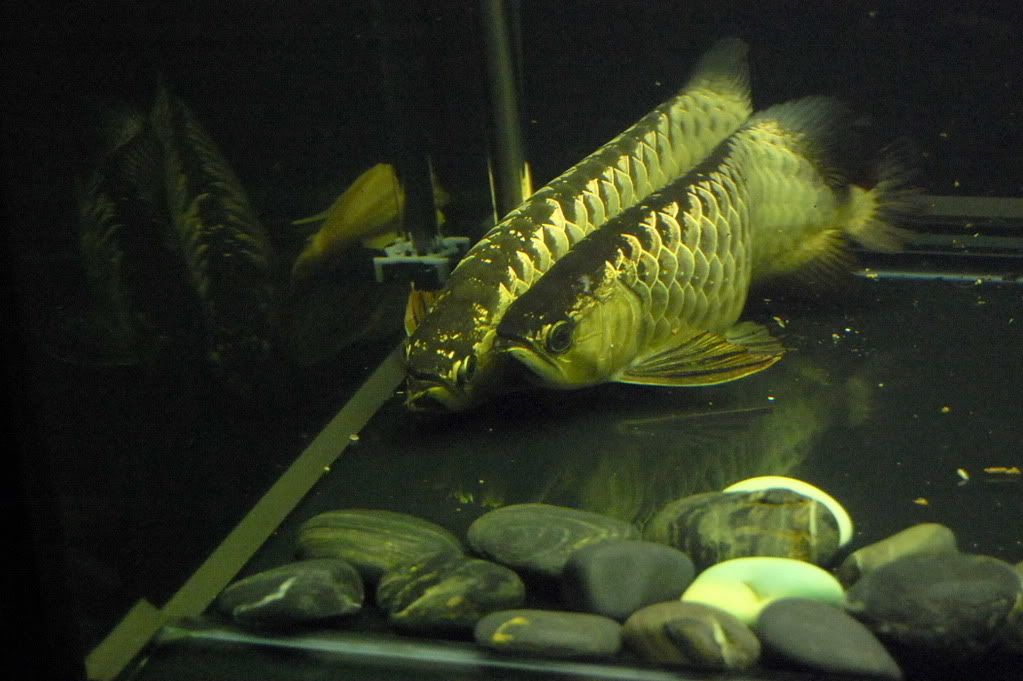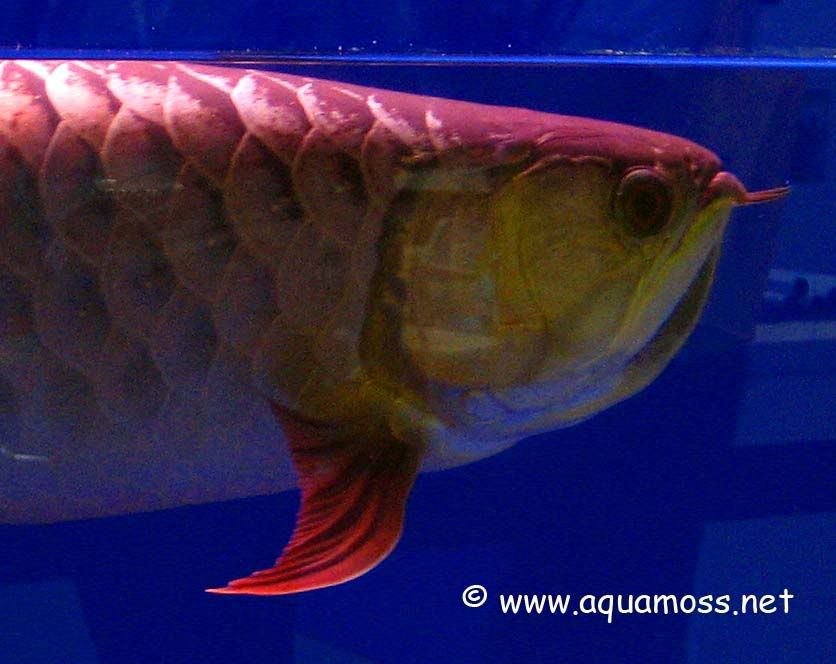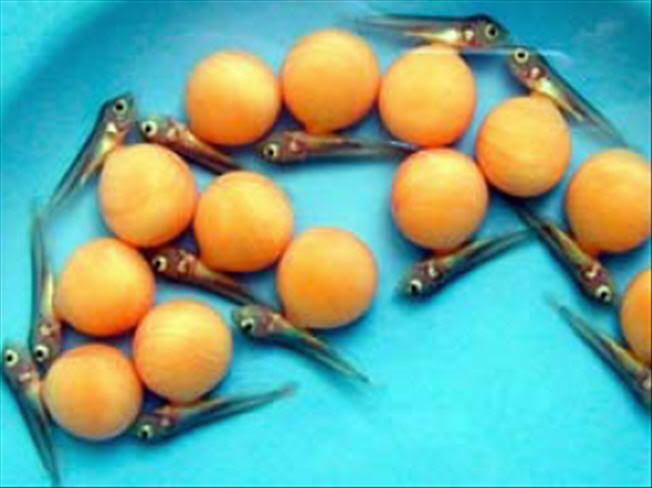ADSENSE Link Ads 200 x 90
ADSENSE 336 x 280
Arowana breeding may be better left to professionals, but if you are the type to take on nearly insurmountable challenges here is what is known. NATURE..
In the wild, Arowana pair by natural selection spending weeks courting. A pair of Arowana will chase and bite each other's tail while courting, eventually together side by side and chasing off other fish before they finally breed. When the females is ready she will lay eggs on slow stream riverbeds, which will be up to 1/2" in diameter and are then fertilized by the male. The eggs are then scooped up by male Arowana and hatched in his mouth. The fry will begin to briefly leave the father's mouth slowly increasing their exposure to the outside world. There will be fewer Arowana than originally consumed. It is believed that the Arowana when startled sometimes accidentally swallows some of the young. During this time, the father will signal the fry when there is a sign of danger and they will immediately swim back immediately for safety. The babies will have a yolk sack that they will use until they are ready to feed on their own. The fry will leave the father when they are capable of surviving on their own. An exception is the Arapaimas who bury their eggs in the sand until they hatch.
TANK BREEDING
There were FEW records that Asian Arowana has been successfully bred in aquariums. Commercial breeders of Arowana usually use large earthen ponds. When breeding in earthen ponds, ten or more mature Arowana (half males, half females) are put into the pond and natural selection is allowed to take its course. The Arowana are observed carefully. When a pair is formed, they will chase the others away and started laying eggs. A net is then put in to segregate the pair from the other Arowana. When the fry are free swimming, they are netted and kept in rearing tanks. However, most aquarist do not have an earthen pond at home or live in a climate suitable to leaving them outside for several months.
http://youtube.com/watch?v=5ltmk6oHXg8
example of a pair arowana..

the mouth brooding male (crossback golden arowana)

fries from the mouth brooder..


arowana fries with egg yolks still attached..
At first not thought possible breeding Arowana in a tank has been acomplished, but much harder due their large size when mature. Many people around the world have started trying to breed Arowana in captivity, but it is nearly impossible. One successful aquaria breeder, Mr. Hiroshi is the most respected fish breeder in Japan. To accomplish his successful breeding in the aquarium environment, he first has access to pairs of adult Asian Arowana that have been successfully breed in pond condition. So the fish are already paired off, and have spawned once before moving into his tank. His basement is dedicated to fish breeding, which reduces the stress of the Arowana. He published the first article on captive breeding of Asian Arowana in 1992 after 20 years of research on this fish. (See the January, 1992 issue of TFH).
Arowana are mouthbrooders. Asian Arowana are hard to sex, especially when they are young. Sexual maturity depends on environmental conditions, but generally females takes 2-3 years and male 4-5 years to reach maturity.enerally, males are larger in size and fin then its female siblings, which give then a more arrogant look. It is believed that they also has wider and deeper jaw(to hold the eggs and fry). Females, on the other hand are smaller and have a more rounded body. It takes a lot of experience to sex mature Arowana, only when they start breeding will you be 100% sure.
There are two ways to pair up aowanas. By natural pairing or matching. Matching is inherently more dangerous as Arowana are territorial. They will inevitably fight if you keep two together. Their aggression decreases when the number of Arowana keep together increased to 6 or more. This is often not possible due to the high price of some species of Arowana. Also, remember that you will need a mighty big tank to hold 6 Arowana. The bigger the tank, the better, with 8'x2'x2' as the minimum.
NATURAL PAIRING - At least six mature Arowana are needed to have a reasonable chance of getting a pair. Young that have grown up together are preferable. If not, they should be placed into the the tank at the same time so that none will have chance to develop a territorial sense earlier then others.
Observe closely until a pair appears to have formed noted by the male swimming closely to the female and chasing the rest away. At this time remove the rest of the Arowana from the tank.
Courting will take place over a 1-2 months period. They will continue to swim closely together, often in circular motion, chasing and biting each other's tails and fins often cause injuries to the body as well. Females usually sustain more injuries, especially in anac fin, genital area and gill cover, possibly due to male trying to stimulate her hormonal secretion.
Their appetite will drop gradually, as the abdomen of the female will start to swell up and filled with eggs. An area, usually a less disturbed area with weak current, will be chosen to lay the eggs. Covering the spawning area of the tank if recommended to avoid disturbing or terminating the spawning due to stress.
At the time of egg release, they will then swim parallel to each other, rubbing against each other and occasionally stayed motionless. Eventually, they will stop swimming, but continue rubbing bodies until, with a sudden spasm, the female will release her eggs and simultaneously the male fertilizes by releasing his sperm. Spawning usually takes place in the afternoon with the number of eggs laid averaging 60 and being up to 1/2" in diameter. The male will immediately scoop up as many eggs as possible with the remainder usually eaten by the female.
During hatching period, female will start to chase the male, possibly violently. It is possible that the male might swallow some eggs accidentally during this chasing therefore it is a good idea to remove the female away at that time.
The yoke sac should be fully absorbed in around 60 days. The fry will then begin to leave the father's mouth, first briefly and slowly increase the duration. You should have a supply of baby guppies on hand at this stage. Once the fry begin to eat readily for a few days they can be removed from the parent. Use standard procedures mentioned in the care section.
MATCHING
This is risky. You should be confident that you have two Arowana of the opposite sex. This takes a lot of experience and should only be tried with extreme care. Arowana can and will fight to the death is paired improperly.
Condition the two Arowana with lots of live food. Put two fish into the breeding tank of at least 175 gallons with a transparent divider between them. Give them time to get accustomed to each other and continue to condition them at the same time.
After several weeks, remove the divider, and watch them carefully. They may be more violent than a pair formed by natural selection. When it gets too violent or fish are injured, put the divider back. Consider whether you may be wrong that they are of opposite sex or are not mature enough yet. If you still feel sure you have a pair give it a few more days and remove the divider again. If you have a pair, the two Arowana will show courting behavior as stated above. Spawning on will similar to natural pair.
0 Response to "Arowana breeding techniques"
Post a Comment